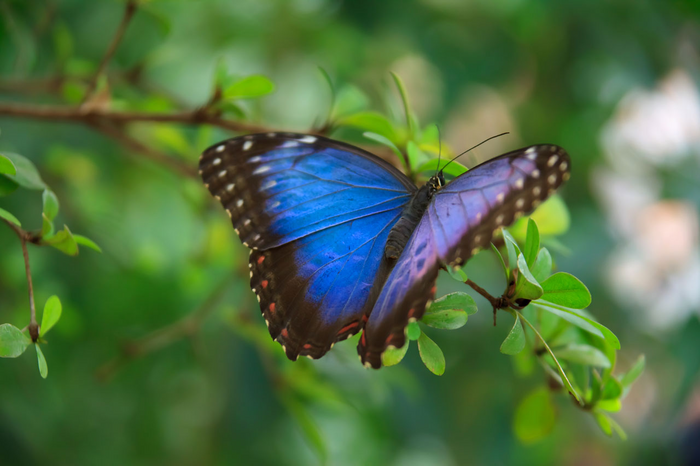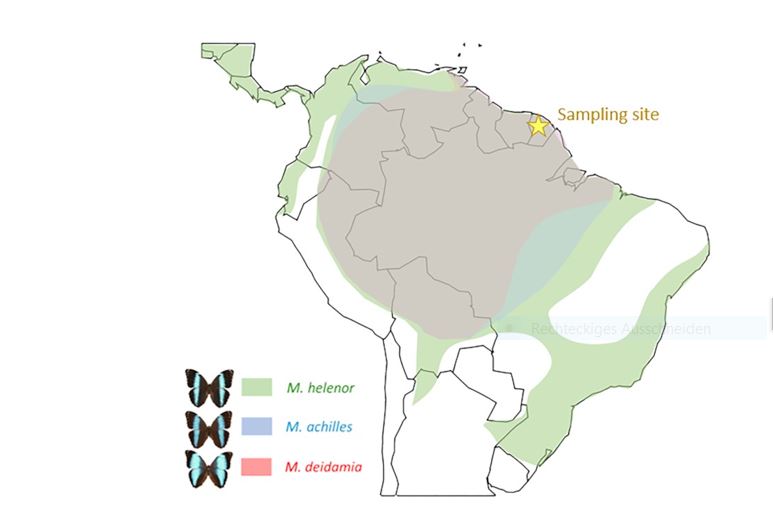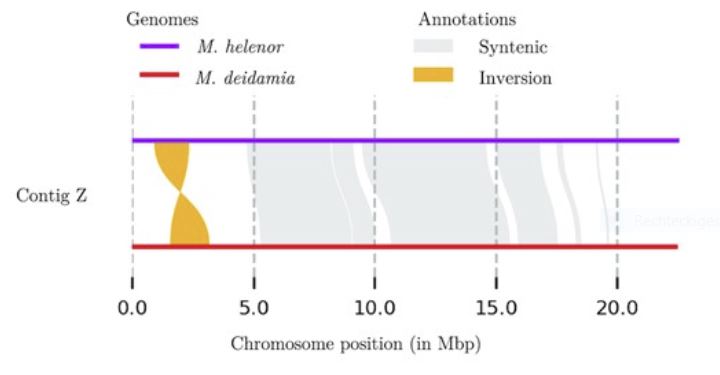Amazonian Morpho butterflies: three genomes with a twist
Morpho butterflies are emblematic species of the Amazonian rainforest known for their metallic shades of blue and green. Despite their conspicuous looks and fascinating biology, large-scale genome sequencing efforts have somewhat neglected them – until now. In a new GigaScience article, Héloïse Bastide and coworkers at IDEEV in Gif-sur-Yvette and at the Muséum National d’Histoire Naturelle in Paris present the first full-length genome sequences for three species of Morpho butterflies: The common blue morpho (M. helenor), the Achilles morpho (M. achilles), and the Deidamia morpho (M. deidamia).

These three Morpho species co-occur in the same habitat – that is, they live in “sympatry,” as evolutionary biologists call it. Previous studies have also shown that Morpho males are attracted to the wing patterns of other similar species besides their own. For our understanding of the process of speciation, this raises a question that has fascinated evolutionary biologists for a long time: If closely related species live in the same habitat, and individuals of different species are sexually attracted to each other, what is the reproductive barrier that keeps them distinct and prevents the separate species from blending back into one?

Part of the answer may lie in the butterflies’ behavior. If the species are active at different times of the day, they are less likely to encounter specimens of their sister species, thus maintaining reproductive isolation.
Other answers to the question of how sympatric Morpho species can become and remain distinct may be found in their genomes. The authors of the new GigaScience study compared the genomes of the three Morpho species and found that their genetic makeup is very similar overall. There is, however, one notable exception on the so-called Z chromosome (one of the sex chromosomes in butterflies), where multiple large-scale rearrangements of genomic material have been detected, and now, thanks to this new high-quality genome sequences, these rearrangements can be characterized in great detail.

For sex determination in butterflies, the females have a WZ sex-chromosome constitution while males are ZZ. Due to the genomic inversions, genetic incompatibilities arise between sister species, which keep the species’ identities separate — even if they live in the same habitat.
Overall, the new high-quality assembly and annotation of these three species of Morpho butterflies reveal differences in chromosome numbers, the presence of several long inversions in the Z chromosome, and genetic divergence among copies of genes that may play a significant role in reproductive isolation. Similar mechanisms have been described previously in other butterfly species, but this new work brings the emblematic Morpho butterflies into play as one of the organisms where fundamental questions of evolution can be studied at a detailed genomic level, and provide far greater understanding of the processes of speciation. The mechanisms underlying the development and sustainment of new species may provide more information on how to maintain biological diversity. As the authors point out in conclusion, “the study opens new avenues into the investigation of the ecological and genomic factors involved in sympatric speciation and its reinforcement.”
Further Reading:
Bastide H; López-Villavicencio M; Ogereau D; Lledo J; Dutrillaux AM; Debat V; Llaurens V (2023): Genome assembly of three Amazonian Morpho butterfly species reveals Z-chromosome rearrangements between closely-related species living in sympatry. GigaScience. Vol 12. Giad033 https://doi.org/10.1093/gigascience/giad033
Data Availability:
Bastide H; López-Villavicencio M; Ogereau D; Lledo J; Dutrillaux AM; Debat V; Llaurens V (2023): Supporting data for “Genome assembly of three Amazonian Morpho butterfly species reveals Z-chromosome rearrangements between closely-related species living in sympatry” GigaScience Database. http://dx.doi.org/10.5524/102362